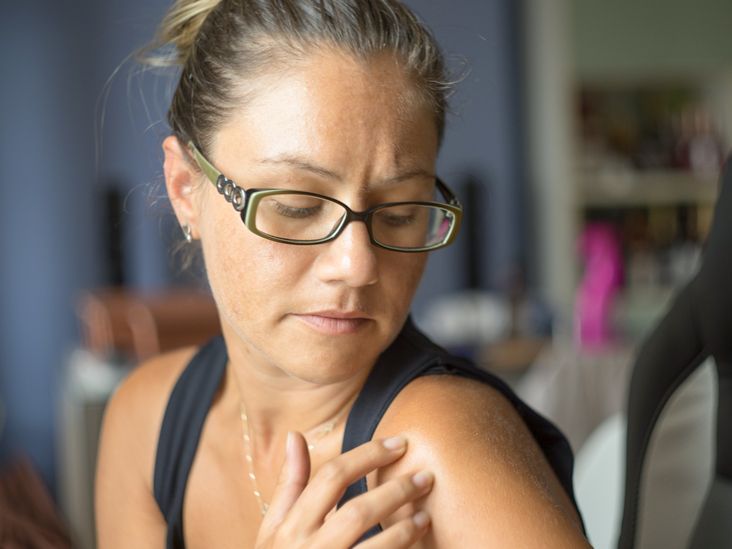
- Select a language for the TTS:
- UK English Female
- UK English Male
- US English Female
- US English Male
- Australian Female
- Australian Male
- Language selected: (auto detect) - EN
Play all audios:
Bezzy communities provide meaningful connections with others living with chronic conditions. Join Bezzy on the web or mobile app.
Melanoma is the rarest and most dangerous type of skin cancer. It begins in the melanocytes, which are the cells in your skin that produce melanin. Melanin is the pigment responsible for
skin color.
Melanoma develops into growths on your skin, which often resemble moles. These growths or tumors may also come from existing moles. Melanomas can form on skin anywhere on your body,
including inside the mouth or vagina.
Metastatic melanoma occurs when the cancer spreads from the tumor to other parts of your body. This is also known as stage 4 melanoma. Melanoma is the most likely of all skin cancers to
become metastatic if not caught early.
The rates of melanoma have been increasing for the past 30 years. It’s estimated that 8,290 people will die from melanoma in 2024.
Unusual moles may be the only indication of melanoma that hasn’t yet metastasized.
Moles caused by melanoma may have the following characteristics:
Asymmetry: Both sides of a healthy mole look very similar if you draw a line through it. Two halves of a mole or growth caused by melanoma look very different from each other.
Border: A healthy mole has smooth, even borders. Melanomas have jagged or uneven borders.
Color: A cancerous mole will have more than one color, including:
Size: Melanomas are more likely to be larger in diameter than benign moles. They usually grow to be larger than the eraser on a pencil.
You should always have a doctor examine a mole that changes in size, shape, or color because it can be a sign of cancer.
Symptoms of metastatic melanoma depend on where the cancer has spread. These symptoms usually only appear once the cancer is already advanced.
If you have metastatic melanoma, you may experience symptoms such as:
Melanoma occurs due to a mutation in melanin-producing skin cells. Researchers currently believe that too much exposure to ultraviolet light, either from sun exposure or tanning beds, is the
leading cause.
Metastatic melanoma occurs when the melanoma is not detected and treated early.
Several risk factors can contribute to developing melanoma. Those with a family history of melanoma have a higher risk than those without. Approximately 10% of people who develop melanoma
have a family history of the disease. Other risk factors include:
Those who are older are more likely to develop melanoma than younger individuals. In spite of this, melanoma is one of the most common cancers in people under 30, especially in young women.
After the age of 50, men have a higher risk of developing melanoma.
The risk of melanomas becoming metastatic is higher in those who have:
If you notice an unusual mole or growth, make an appointment to get it checked by a dermatologist. A dermatologist is a doctor who specializes in skin conditions.
If your mole looks suspicious, your dermatologist will remove a small sample to check for skin cancer. If it comes back positive, they’ll likely remove the mole completely. This is called an
excisional biopsy.
They’ll also evaluate the tumor based on its thickness. Generally, the thicker the tumor, the more serious the melanoma. This will affect their treatment plan.
If melanoma is detected, your doctor will run tests to make sure the cancer hasn’t spread.
One of the first tests they may order is a sentinel node biopsy. This involves injecting dye into the area the melanoma was removed from. The dye moves to the nearby lymph nodes. These lymph
nodes are then removed and screened for cancer cells. If they’re cancer-free, it typically means the cancer hasn’t spread.
If the cancer is in your lymph nodes, your doctor will use other tests to see if the cancer has spread anywhere else in your body. These include:
Treatment for a melanoma growth will begin with excision surgery to remove the tumor and cancer cells around it. Surgery alone can treat melanoma that hasn’t spread yet.
Once the cancer has metastasized and spread, other treatments are required.
If the cancer has spread to your lymph nodes, the affected areas may be removed through lymph node dissection. Doctors may also prescribe interferon after surgery to reduce the likelihood of
the cancer spreading.
Your doctor may suggest radiation, immunotherapy, or chemotherapy to treat metastatic melanoma. Surgery may be used to remove cancer in other parts of your body.
Metastatic melanoma is often hard to treat. However, many clinical trials are underway that are looking for new ways to treat the condition.
The treatments for metastatic melanoma can cause nausea, pain, vomiting, and fatigue.
Removal of your lymph nodes can disrupt the lymphatic system. This can lead to fluid buildup and swelling in your limbs, called lymphedema.
Some people experience confusion or “mental cloudiness” during chemotherapy treatment. This is temporary. Others may experience peripheral neuropathy or damage to the nerves from the
chemotherapy. This can be permanent.
Melanoma is curable if caught and treated early. Once melanoma has become metastatic, it’s much harder to treat. The average five-year survival rate for metastatic melanoma is as low as 35
percent based on how far it has spread in a person’s body.
If you’ve had metastatic melanoma or melanomas in the past, it’s important to continue to get regular follow-ups with your doctor. Metastatic melanoma can recur and can even come back in
other parts of your body.
Early detection is essential to treating melanoma successfully before it becomes metastatic. Make an appointment with your dermatologist for annual skin cancer checks. You should also call
them if you notice new or changing moles.
Amelanotic melanoma is a unique type of melanoma, usually with no pigment. Here's how to recognize it.
Melanoma may develop in your feet and nails. Here's how to spot it and what to do.
It isn't unusual for moles to disappear without a trace. Here's why it happens and when to be concerned.
Moles are something we all have. We can be born with them or they can develop during childhood or times of hormonal change, like pregnancy. But a new…
Learn how fast melanoma spreads and what factors can affect spread.
Here's what experts say about itching and melanoma, and the signs you need to look for in a mole or skin lesion.
The American Academy of Dermatology believes that red light therapy is safe in the short term. But more research is needed to fully understand the…
The uvea is a layer of the eye. Melanoma cancer is fast spreading and can affect this layer. Here's all you need to know.
Here’s the difference in causes, symptoms, look, and treatment between melanoma and carcinoma of the skin.
Doctors can use PET scans to detect melanoma in some stages. Here’s all you need to know.




:max_bytes(150000):strip_icc():focal(216x0:218x2)/hillary-clinton-3-435-9609410055dd4b48b60767ea5f67acec.jpg)
